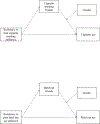Resistance to peer influence, smoking friends, cigarette and betel nut use, and gender among Pacific Islander youth
- PMID: 38206103
- PMCID: PMC11236956
- DOI: 10.1080/15332640.2023.2295933
Resistance to peer influence, smoking friends, cigarette and betel nut use, and gender among Pacific Islander youth
Abstract
The present study examined the relationships between resistance to peer influence and cigarette and betel nut use, as well as the potential mediating role of friends who use cigarettes and betel nut, among boys and girls in Guam. This study included 673 ethnically diverse students (49% female; M age = 12.7, SD = 0.89) from eight public middle schools. The mediation analysis demonstrated that higher resistance to peer influence for both cigarette and betel nut use was associated with lower cigarette and betel nut use directly and that this association was mediated by friends who used cigarette and betel nut products. That is, low resistance to peer influence for both cigarette and betel nut use was associated with a greater number of friends who smoke and use betel nut, which was linked with more cigarette and betel nut use. The moderated mediation analysis revealed no gender difference in the indirect effect (i.e., the mediation of friends who used cigarettes and betel nut). These findings can be used to inform the design and implementation of intervention and prevention programs for at-risk youth, regardless of gender, who are vulnerable to substance use in the Pacific.
Keywords: Pacific Islander youth; Resistance to peer influence; cigarette and betel nut use; friends who use cigarettes and betel nut.
Conflict of interest statement
Disclosure of potential conflicts of interest: The authors report there are no competing interests to declare.
Figures



Similar articles
-
Heated tobacco products for smoking cessation and reducing smoking prevalence.Cochrane Database Syst Rev. 2022 Jan 6;1(1):CD013790. doi: 10.1002/14651858.CD013790.pub2. Cochrane Database Syst Rev. 2022. PMID: 34988969 Free PMC article.
-
Smoking cessation medicines and e-cigarettes: a systematic review, network meta-analysis and cost-effectiveness analysis.Health Technol Assess. 2021 Oct;25(59):1-224. doi: 10.3310/hta25590. Health Technol Assess. 2021. PMID: 34668482
-
Tobacco packaging design for reducing tobacco use.Cochrane Database Syst Rev. 2017 Apr 27;4(4):CD011244. doi: 10.1002/14651858.CD011244.pub2. Cochrane Database Syst Rev. 2017. PMID: 28447363 Free PMC article.
-
Interventions for waterpipe smoking cessation.Cochrane Database Syst Rev. 2015 Jul 31;2015(7):CD005549. doi: 10.1002/14651858.CD005549.pub3. Cochrane Database Syst Rev. 2015. Update in: Cochrane Database Syst Rev. 2023 Jun 7;6:CD005549. doi: 10.1002/14651858.CD005549.pub4. PMID: 26228266 Free PMC article. Updated.
-
Electronic cigarettes for smoking cessation.Cochrane Database Syst Rev. 2022 Nov 17;11(11):CD010216. doi: 10.1002/14651858.CD010216.pub7. Cochrane Database Syst Rev. 2022. Update in: Cochrane Database Syst Rev. 2024 Jan 8;1:CD010216. doi: 10.1002/14651858.CD010216.pub8. PMID: 36384212 Free PMC article. Updated.
References
-
- Byrnes JP, Miller DC, & Schafer WD (1999). Gender differences in risk taking: A meta-analysis. Psychological bulletin, 125(3), 367–383.
-
- Centers for Disease Control and Prevention. (2022). Youth and tobacco use. Retrieved from https://www.cdc.gov/tobacco/data_statistics/fact_sheets/youth_data/tobac....
-
- Chapple C, Vaske J, & Worthen MG (2014). Gender differences in associations with deviant peer groups: Examining individual, interactional, and compositional factors. Deviant behavior, 35(5), 394–411. 10.1080/01639625.2014.855098 - DOI
Grants and funding
LinkOut - more resources
Full Text Sources
